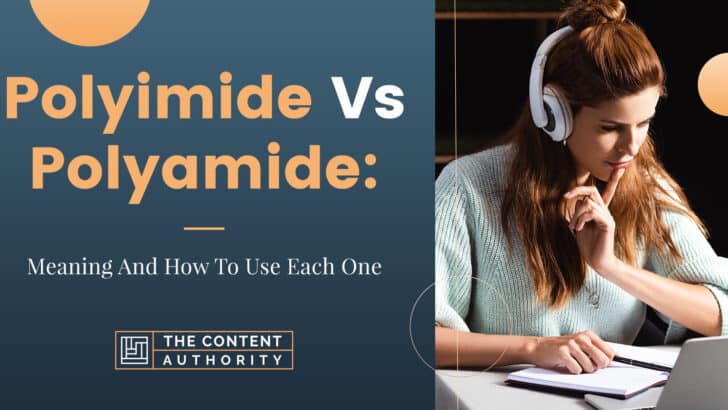There is a high usage of polymers across the industries; these are compounds made using monomers. While there are various types of polymers, there are two that confuse many people: polyimide and polyamide. People have difficulty distinguishing them because of their near spellings, which we will address in this polyimide vs polyamide article.
Polyimide is any class of polymers with an imido link -CO-N-OC, and they are resistant to high temperatures, wear, radiation, and numerous chemicals. In comparison, polyamide is a polymer with monomer units linked together by the amide group -CONH-.
People confuse “polyimide” and “polyamide” because they are both polymer compounds, highly resistant to temperature, and can be used in a wide range of applications. They are also popular because of their physical, excellent electrical properties, and thermal stability. However, these polymers are not the same; read this article to learn about their meanings, differences, and usage.

Definitions Of Polyimide And Polyamide
Polyimide and polyamide have near spellings and meanings, which is why most people confuse these words. However, one of the ways that you can deal with this is by learning the definition of each word. Looking up the meaning from the dictionary will give you a clear picture of the difference between these words and how to use them. That way, you will have an easy time when talking or writing about these polymers.
Definitions Of Polyimide
Polyimide (noun) is a polymer whose monomers are imides; they are used in making high-temperature resin. It belongs to a class of polymers that are resistant to high temperatures, wear, and radiation.
Other sources define polyamide (noun) as a synthetic resin in which the amide groups link the polymer units. These polymers are mainly used in making heat-resistant coatings and films.
Polyamide (noun) is a polymer classified as a high-performing plastic. They are heat resistant and are used in numerous applications requiring damaging rugged products like kitchen utensils, sportswear, the automotive industry, textiles, and carpets.
Definitions Of Polyamide
Polyamide (noun) is any range of polymers with amide or peptide repeats units. Polyamides are resistant to high temperatures, wear, radiation, and numerous chemicals. The polymer has repeated amino acids.
It is mainly used to make items that require strength and flexibility, such as clothing, fishing line, ears, guitar picks, and several medical implants.
How To Properly Use Polyimide And Polyamide In Sentences
Though it is important to learn the definition of words, the information you get when you do might not be enough to know how to use these words in your sentences. That’s also the case when learning about molecule structures such as polyamide and polyamide. The solution is learning how to use these words in your sentences. Let’s focus on that below.
How To Use The Word Polyimide
Each time you use the word polyimide in your sentences, you should refer to a type of polymer. Unlike some English words with more than one meaning, that’s not the case when discussing polyimide. One of the ways that you can use the word “polyimide” is when talking about a polymer formed between the reaction of dianhydride and diamine.
You can also use the word polyimide when referring to a polymer made using the monomers dianhydride and diisocyanate.
More so, use the word polyimide when referring to polymers with superior thermal stability, chemical resistance, and mechanical properties. These polymers have a characteristic yellow color. Since they are resistant to flame combustion, there is no need to use them with flame retardants.
Polyimides can be classified into two categories thermosetting and thermoplastic. Depending on the constitution of the chain, it can be further classified into other categories: aromatics, semi-aromantic, and aliphatic.
These compounds replace materials like metals, glass, and steel. It is an attractive dielectric material. You’ll also find it in various fields, such as the automobile, aerospace, and electronics, since it is suitable for harsh conditions.
Despite the many benefits of polyimide polymer, it also has its limitations, such as high manufacturer cost, high-temperature requirements, and specified operating processes like annealing operations at certain temperatures.
How To Use The Word Polyamide
A common assumption is that people can use the word polyamide as a synonym for polyimide, but that is not true. Use the word polyamide when referring to high-performance thermoplastic elastomers characterized by their good heat aging, solvent resistance, and high service temperature.
You can also use the word polyamide when referring to polymers with low friction coefficient, impact properties, and high abrasion resistance.
Polyamides are also polymers made by repeating the amide linkages (-CO-NH-) and can be either natural or synthetic. Some of the common natural polyamides are proteins, silk, and wool. In contrast, some common synthetic polyamides are amides, carbamide-methanal, and nylon.
Polyimide Vs. Polyamide: More About These Words
After understanding the definition and usage of polyimide and polyamide, it is time to understand the differences based on grammar and science. These compounds’ popular usage include switches, connectors, wheel trims, engine covers, header tanks, and airbrake tubing.
Here’s more on what you need to know, especially if you plan to use these words commonly.
Linkage And General Names
Polyimide has a repeated imide linkage, while polyamides have repeating amide linkages. More so, the most recognized general name for polyimide is Kapton, while that of polyamide is Nylon and Kelvar.
Spelling
The words polyimide and polyamide have near spellings; if you are not keen, you might confuse them and use the wrong spellings in your work. So, learn the correct spellings and the appropriate ways to spell these words.The correct spelling of the word polyamide is “P.O.L.Y.I.M.I.D.E,” while the correct spelling of the word polyamide is “P.O.L.Y.A.M.I.D.E.”
Pronunciation
Though the word polyimide and polyamide have near spelling and pronunciation, it is important to learn the difference. That way, you will make the correct pronunciation when talking about any of these polymers. The correct pronunciation of the word polyimide is “pol-ee-im-ahyd.” Pronounce the word polyamide as “pol-ee-am-ahyd.”

List Of Examples Of Polyimide And Polyamide In Sentences
One of the ways you can know more about words that seem confusing is to learn from their usage in different sentences. Doing this will let you know how to apply each word. In addition, you will notice the different contexts the words have been used in. With that in mind, learn more about polyimide and polyamide by reading the sentences below.
Example sentences of the word polyimide
- The current production needs a lot of polyimide.
- Is it true that coils are made using a single polyimide?
- Polyimide is great for this project since it has great thermal stability.
- You will have to heat the polymeric acid fibers to get polyimide nanofibers.
- The new research was on the isomer distribution of PM polyamide resin solution.
Example sentences of the word polyamide
- The hair nets that the company manufactures have quality polyamide polyester.
- What is the right method of preparing large fiber-reinforced polyamide molding?
- It is important to ensure that everything gets covered with a breathable polyamide-merino-elastane face fabric.
- They said that the jerseys are made of soft polyamide.
- If you want the best outcome, get a polyamide consisting of polyetheramine and nylon.
Conclusion
People often confuse polyimide and polyamide due to their very similar word characters. Some use these words as synonyms, but they are two different compounds with varying structural and chemical properties.
Therefore, you need to learn the difference between these two compounds if you plan to use these words often. Even those in chemistry should be very keen on the words. A slight mistake in mixing the chemical compounds could lead to serious reactions, damages, or wrong results.
Shawn Manaher is the founder and CEO of The Content Authority. He’s one part content manager, one part writing ninja organizer, and two parts leader of top content creators. You don’t even want to know what he calls pancakes.

